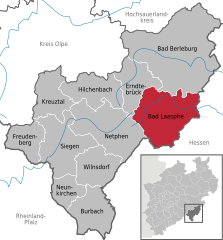Loading AI tools
Town in North Rhine-Westphalia, Germany From Wikipedia, the free encyclopedia
Bad Laasphe (German: [baːt ˈlaːsfə] ⓘ) is a town in North Rhine-Westphalia, Germany, in the Siegen-Wittgenstein district.
Bad Laasphe | |
|---|---|
 | |
Location of Bad Laasphe within Siegen-Wittgenstein district  | |
| Coordinates: 50°55′49″N 08°25′00″E | |
| Country | Germany |
| State | North Rhine-Westphalia |
| Admin. region | Arnsberg |
| District | Siegen-Wittgenstein |
| Subdivisions | 24 |
| Government | |
| • Mayor (2020–25) | Dirk Terlinden[1] |
| Area | |
• Total | 135.76 km2 (52.42 sq mi) |
| Highest elevation | 694 m (2,277 ft) |
| Lowest elevation | 300 m (1,000 ft) |
| Population (2023-12-31)[2] | |
• Total | 13,504 |
| • Density | 99/km2 (260/sq mi) |
| Time zone | UTC+01:00 (CET) |
| • Summer (DST) | UTC+02:00 (CEST) |
| Postal codes | 57334 |
| Dialling codes | 02752, 02753, 02754, 02774 |
| Vehicle registration | SI |
| Website | www |
The town of Bad Laasphe lies in the upper Lahn Valley, near the stately home of Wittgenstein Castle (de) (nowadays a boarding school) in the former Wittgenstein district. The municipal area is located south of the main crest of the Rothaargebirge, and borders in the north on the towns of Bad Berleburg and Erndtebrück, in the east on the town of Biedenkopf in Hessen, in the southeast on Breidenbach, in the south on Dietzhölztal and in the west on the town of Netphen. Bad Laasphe lies about 30 km east of Siegen and 25 km northwest of Marburg.
The highest elevation in the municipal area rises to 694 m. It lies southwest of the main town at the outlying centre of Heiligenborn.

Each one of the following centres is part of the town of Bad Laasphe:
|
|
|
In 1888, the town of Laasphe lay in the Prussian administrative region of Arnsberg in Wittgenstein district and was connected to the Kreuzthal-Marburg line of the Prussian State Railway (Preußische Staatsbahn). In 1888 Laasphe had a junior teachers' college, a local court and knitwear and hosiery factories. In 1885, Laasphe had 2225 mostly Evangelical inhabitants. Schloss Wittgenstein owned two ironworks. (From Meyers Konversations-Lexikon)
Since 1960, Laasphe has been a Kneipp spa. On 1 January 1984 the town became a Kneipp curative spa for its mild climate, and since then has been called Bad Laasphe.
This section needs to be updated. (June 2021) |
The results of the local council elections in May 2014[3] were:
| Party | % | Seats |
|---|---|---|
| SPD | 40,5% | 13 |
| CDU | 39,0% | 12 |
| FDP | 11,7% | 4 |
| Alliance '90/The Greens | 8,8% | 3 |
Bad Laasphe's civic coat of arms might heraldically be described thus: In sable a town wall with open gate tower argent flanked by two crenellated towers argent, between which an inescutcheon in argent two pallets sable.
A stamping of the town's seal from the 14th century has been preserved, which shows the same composition as the arms shown here. The inescutcheon (smaller shield within the main one) bears the same arms as the town's former overlords, the Counts of Wittgenstein. When the arms were revised in 1908, the town came up with another composition which looked the same, but the inescutcheon, owing to a misunderstanding, was rather different, being quartered with two opposite quarters showing in gules (red) a castle argent (silver), and in the two other quarters the Wittgenstein pallets. The castle charge was a modern addition and related to the Wittgensteins' overlordship in Homburg. The town archive suggested even then that the inescutcheon bear the old Wittgenstein arms as seen in the town's oldest known seal, but no decision was made about it at that time. Only in 1936 did the town finally decide to revert to the composition shown in the old seal. This was confirmed as the town's arms on 10 March 1937.

Seamless Wikipedia browsing. On steroids.
Every time you click a link to Wikipedia, Wiktionary or Wikiquote in your browser's search results, it will show the modern Wikiwand interface.
Wikiwand extension is a five stars, simple, with minimum permission required to keep your browsing private, safe and transparent.